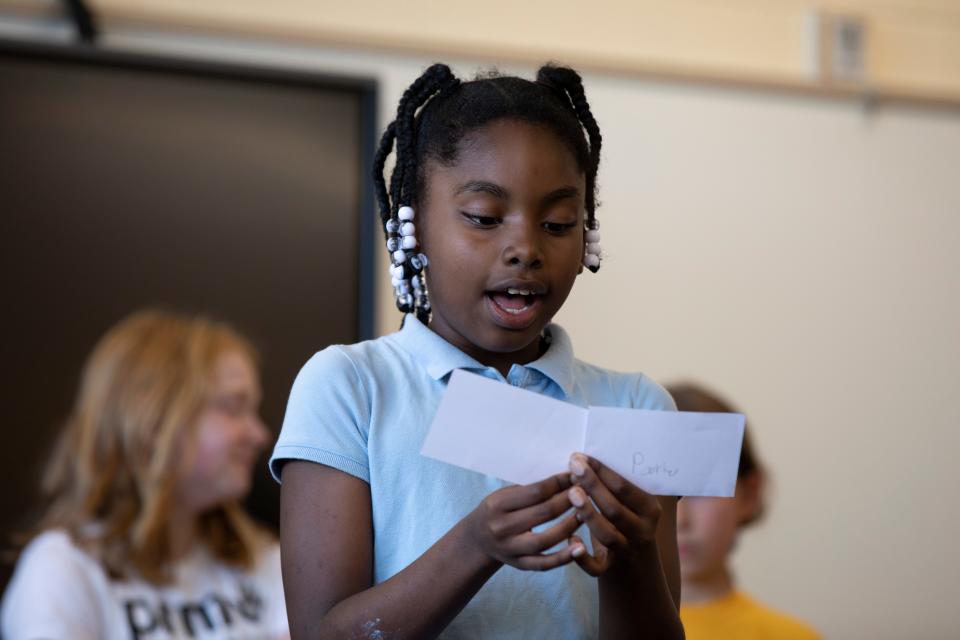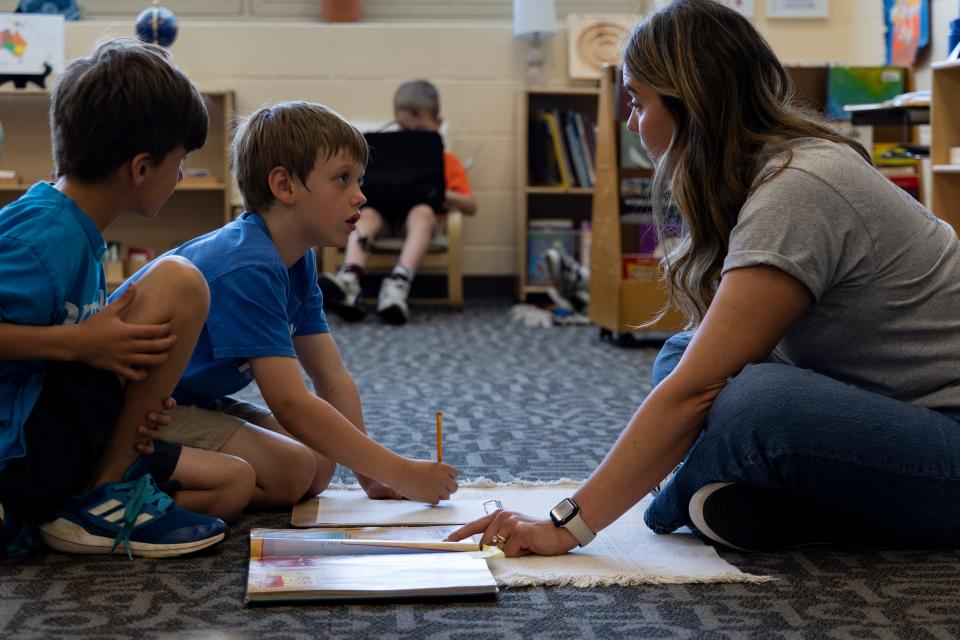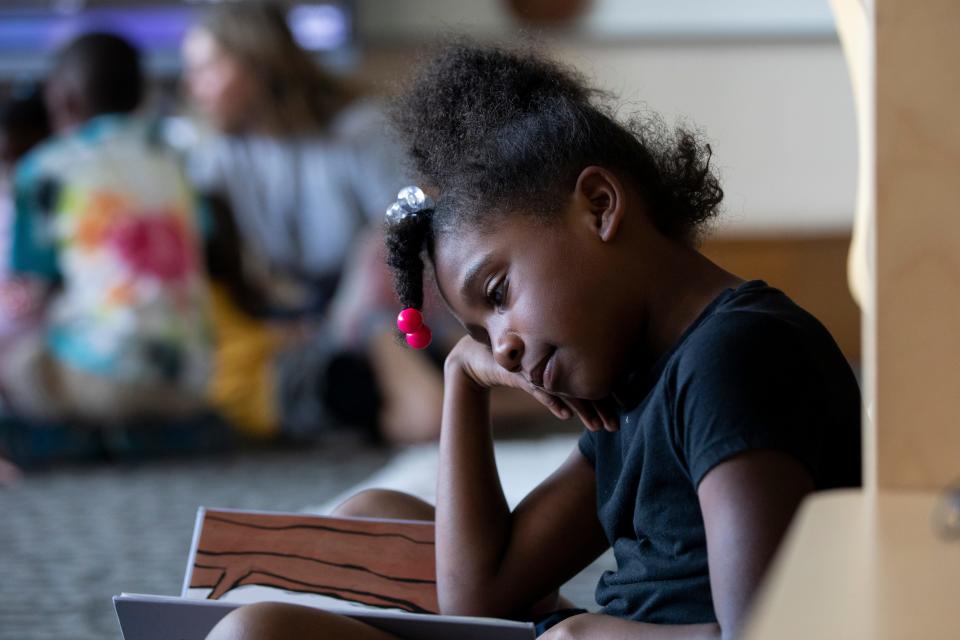Cincinnati Public Schools adopts new Montessori curriculum
- Oops!Something went wrong.Please try again later.
Cincinnati Public Schools is home to the nation's oldest public Montessori school, Sands Montessori, and is well known across the country for providing top-notch Montessori education − a schooling style traditionally reserved for kids attending expensive private schools − to public school students.
Now, the district is on its way to getting every one of its Montessori schools certified by the American Montessori Society after the board approved a new Montessori curriculum.
Teachers, parents and administrators came together over the last three years to build this curriculum, which they feel can serve as a model for other public school districts hoping to build a Montessori program.
What is Montessori?
Dr. Maria Montessori, an Italian physician, developed Montessori schooling in the early 1900s.
The Montessori framework allows teachers to build strong relationships with their students over multiple years, provides space and flexibility for individualized learning and is rooted deeply in community.

The informal approach focuses on hands-on projects, groups kids in multi-age classrooms and encourages child-led learning, according to the American Montessori Society. Students get to choose when to tackle different subjects throughout their day by working in groups, by themselves or by teaching each other.
How many students in Cincinnati Public Schools receive Montessori education?
One in 6 CPS students are in a Montessori school.
There are 35,860 students in the district, according to state data, nearly 6,000 of whom receive Montessori education.
What's the history of Montessori at Cincinnati Public Schools?
Sands Montessori in Mount Washington opened in 1975 as the nation's first public Montessori school, according to its website. It had a different name and location then: Children's House in Mount Adams. Clark Montessori High School was founded nearly two decades later, as the nation's first public Montessori high school.
But Montessori roots in Cincinnati came before either of those schools were founded, because of programming at Xavier University. Xavier established the nation's first graduate Montessori teacher training school in 1965.
Nationwide, Montessori is largely private, said Sarah Tierney, director of instructional equity for CPS. But the district is part of a growing group of public school districts across the country working together to make Montessori more accessible. Educators in Cleveland and Tulsa have reached out recently to get insight from CPS Montessori leaders.
"We ... talk once a month about issues in our districts and how we can better deliver the Montessori philosophy and instruction in a public setting," Tierney said.
If Montessori has been in CPS for almost 50 years, why did it take so long to build a curriculum?
No one seems to have a definitive answer to this one, but there are theories.

Most consistently CPS leaders told The Enquirer there were challenges to appease the Montessori philosophy that's against frequent testing, while still following Ohio state education standards.
"I think it was taking time to get up the courage to do it, and the courage to challenge and find that avenue where we could properly advocate for a Montessori curriculum," school board member Eve Bolton said.
Aren't CPS Montessori high schools already accredited?
Yes.
Clark Montessori High School − the nation's first public Montessori high school − and James N. Gamble Montessori High School went through an accreditation process five years ago, Clark Principal Eric Higgins said. Because of that, all of the district's high school Montessori teachers who teach core classes − math, science, history and English − as well as foreign language instructors are now Montessori trained.
The schools use Cincinnati Montessori Secondary Teacher Education Program, a company that provides trainings over the summer and over some weekends throughout the school year, to keep teachers up to date on their certification.
Which CPS Montessori schools aren't accredited yet? How long does the accreditation process take?
The elementary Montessori schools within CPS have yet to be accredited.
That includes:
Dater Montessori School.
James N. Gamble Montessori Elementary.
North Avondale Montessori School.
Parker Woods Montessori School.
Pleasant Ridge Montessori School.
Sands Montessori School.

The district will need to meet all eligibility requirements before applying for accreditation, including training its Montessori teachers and staff to earn Montessori certifications. That can take up to three years.
What's the significance of adopting a new curriculum and being accredited by the American Montessori Society?
Adopting a new curriculum provides consistency and alignment across all CPS Montessori schools. That in turn reinforces teachers' instructional methods and should ease stress over daily lesson planning, said Sarah Lofquist, who teaches students in grades 1-3 at Pleasant Ridge Montessori.
"As a teacher, it gives me a lot more freedom in feeling like the people who are surrounding me really believe in how I teach," Lofquist said. "It makes me feel more confident in the content that I'm teaching, which means that my students are with a teacher who's feeling more confident."

The accreditation process further establishes confidence in CPS Montessori teachers − and in parents, too.
"There's so many questions and concerns about education now," Bolton said. The accreditation "validates it, also, for parents who might want to make sure that this is actually Montessori. It's not some sort of 'Montessori Lite.'"
Will students notice any changes with this new curriculum?
High school students won't notice any significant changes, Principal Higgins said. But some elementary students might see changes as far as which grade levels are banded together.
Will CPS open a third Montessori high school? When?
Maybe.
Board member Bolton told The Enquirer that the growth in Montessori education in the district means CPS must contemplate opening a third Montessori high school "in the very near future." She based this on growing enrollment in feeder schools.
It's not a new suggestion, she said. Various board members have tossed ideas around about expanding Montessori high school space for the last five years or so.
If finances allow, Bolton said, "it would almost have to happen in the next few years, because of the demand."
Bolton said there might be a need for an additional Montessori elementary down the line, too.
This article originally appeared on Cincinnati Enquirer: CPS adopts Montessori curriculum: What it means for students

